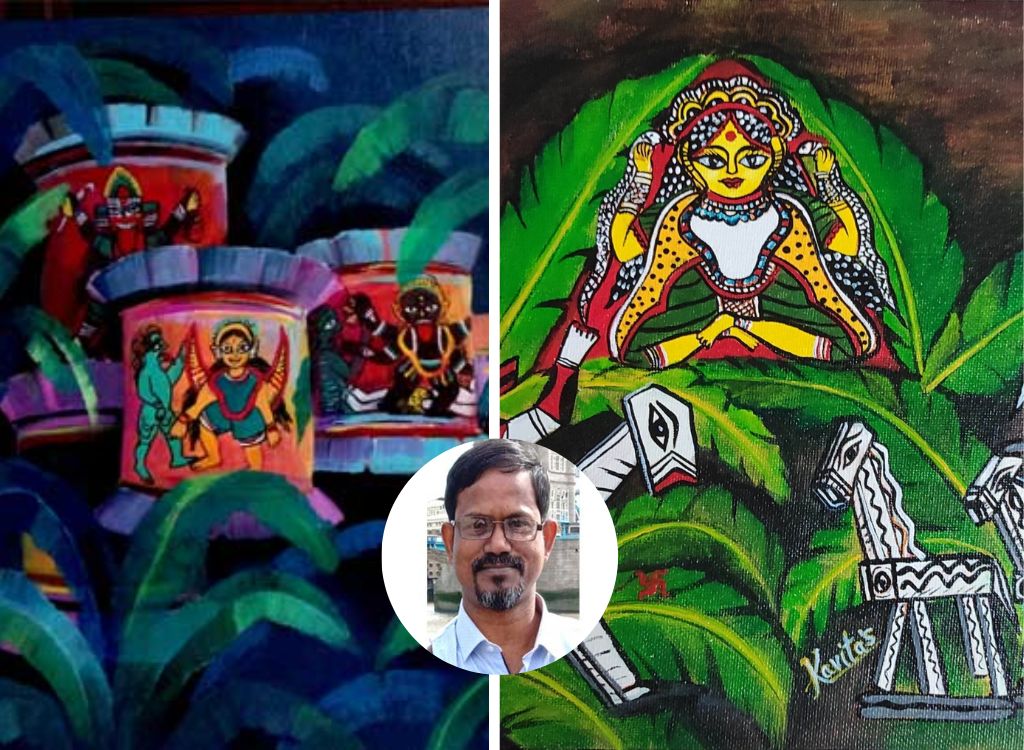
Indian art is a vibrant and diverse category that has a rich history dating back thousands of years. Indian art has evolved over time, influenced by various cultures and religions that have made their mark on the subcontinent. From the traditional paintings of the Mughal and Rajput courts to the modernist works of contemporary artists, the category of Indian art is a juggernaut that has no parallels. The art styles of India are known for their diverse range of themes and styles, including those that depict the folklore and various indigenous Gods of India, each with their own unique backgrounds. The Masan paintings of Bengal are one such unique art style that represents a unique and interesting section of Indian culture.
The sources of inspiration for Masan paintings are the Masan Devtas or Masan demigods of an ancient Tibetan sect of Tantric Buddhism, in which the demigods would be worshipped in or near a crematorium. The word ‘Masan’ itself is Bengali for ‘smashan’ or crematorium in Hindi. The origins of Masan paintings lie in the worship of the Masan Devtas, who were worshipped for their healing and protective powers- the paintings were made to help people visualise them during Masan Puja, or the worship of the Masan demigods.
Rajbanshi Tribe and Masan Paintings
Owing to their origins in Tibet, the earlier forms of the Masan paintings greatly resembled the famous Thangka paintings of Tibet, but as the art style travelled with the worship of the demigods throughout the eastern region of the Indian subcontinent via the silk road and other trade routes, it grew into what could be called an Indianised form of Thangka paintings. Today, Masan paintings are primarily made in the North eastern regions of India, the epicentre of the craft being West Bengal. It is also widely made in Bangladesh.
Since the Indianisation of the Masan religion and paintings, they have primarily been made by the Rajbanshi tribe that is, today, widespread in Bengal. This is the only tribe still practising the worship of the Masan Devtas, and this culture is dwindling even amongst them today.
Characteristics of Masan Paintings
The Masan paintings are vibrant and intricate- they usually have a bright red background and depict an Indianised form of the ancient Tantric religion they have their origins in. The characters painted can look frightening and bizarre, having been inspired by Tantric themes. In addition to these themes, the tribe has also diversified the themes, including other tribal Gods and practices. The paintings also depict various celebratory events like the birth of a child and marriages or are also made for their supposed healing and protective powers. When someone in a house was unwell, priests called ‘Ojhas’ would bring the paintings to that house and perform some rituals and pujas, which supposedly helped the sick. The paintings were traditionally made on a silk cloth, but are painted on Shola, or thin sheets of Indian cork today. They may, in rare cases, also be made on paper.
The Masan paintings are made with colours derived from natural elements. The brushes are also made by the artists themselves. The artists are garland makers of the Rajbanshi tribe, called Malakars.
Decline of Masan Puja and Masan Paintings
Today, Masan Puja and Masan paintings are declining practices. Both of them are practised mostly by old fashioned senior citizens amongst the Rajbanshi tribe, and the younger generation has moved on from the traditions of Yore. However, there has been a surge in the number of artists who are shifting their interests to traditionals arts, and this holds true for Masan paintings as well.
Notable Masan Painter

There have been many young artists, of not only the Rajbanshi tribe, but of other tribes too, who have shifted their focus to practising and preserving this beautiful art form. One such artist is Madhusudhan Das, who has brought Masan paintings to the limelight not just in India, but in the world. Madhusudhan Das is the most popular artist of Masan paintings. He is an artist who graduated with a masters in fine arts from the Vishwabharathii university at Shantiniketan, founded by Tagore himself. He first popularised the art form in India, and was awarded a scholarship by the ministry of Human Resources Development in the 1990s, also winning a gold medal in an All India Art Festival. From the national level, he has advanced to the international level, having his artworks exhibited in solo exhibitions in several cities across the world, including New York, Singapore and London. Some of his exhibitions were entirely supported by the Indian High Commission. He has helped immensely in preserving and popularising this ancient art form in this age of soulless modernisation.
Preservation of Masan Art
Masan art is a unique art form that transcends what it appears to be- a painting, no matter how beautiful. Masan art represents centuries of syncretism of various cultures and religious beliefs- each painting is a piece of history, concentrated into a single sheet of cork. It is, hence, important that we realise this and support artists like Madhusudhan Das, who are working tirelessly for the preservation of the art. This is an age of modernisation, which has mostly been bad for traditional artists. However, we must also start reaping the benefits modernisation holds- making traditional art forms such as these accessible all over the world, for example. Supporting traditional art is easier than ever today, and Indians, as a community, must come together and help preserve the unique art and craft forms that represent centuries of our history and culture.





